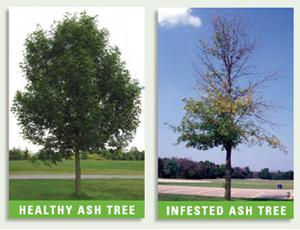Ash trees are dying in Ontario
As many of you have already noticed ash tress in Peel, Halton, GTA and York region are dying while others are being infested by the Emerald Ash Borer (EAB). The Emerald Ash Borer (EAB) is a highly destructive invasive insect that attacks and kills all species of ash trees native to North America. This invasive pest tunnels underneath the bark, cutting off the flow of water and nutrients and killing the tree within a few years.
Introduced from Asia in the early 1990s, but discovered in the Detroit and Windsor areas only in 2002, it is believed that the insect was brought to North America unintentionally via wooden packing crates. In 2008 the CFIA confirmed the presence of EAB in Mississauga. EAB has been confirmed across southwestern Ontario and has been identified as far east as Montreal and it has been declared an invasive alien species by the Canadian Food Inspection Agency (CFIA) and is therefore subject to quarantine (that means that movement of ash wood products outside of the quarantine area is prohibited). A large section of southwestern Ontario is now under quarantine.
There are somewhere between 700,000 – 1ooo,000 ash trees in Mississauga alone. EAB invasion will have a devastating impact on our urban forest. While, as part of its Emerald Ash Borer (EAB) management program for City-owned trees, the City is in the process of inspecting woodlots and identifying trees for removal due to the declining health and increasing hazard of trees infected by EAB; there is no similar programme for privately owned trees as they are considered the responsibility of the owner.
There are things you can do:
- learn how to identify ash trees
- look for signs of EAB infestation – see the Emerald Ash Borer fact sheet – most common signs of EAB infestation include:
- bark damage – vertical cracks appear in the bark
- shoots growing from the trunk and branches o f the tree
- crown dieback – loss of leaves in the tree canopy
- discoloration or yellowing of the leaves
- D-shaped exit holes
- increased presence of woodpeckers feeding
- determine if treatment can save your ash tree
- hire a qualified landscaping company if removal is required
- plant alternative native trees to protect our urban forest

